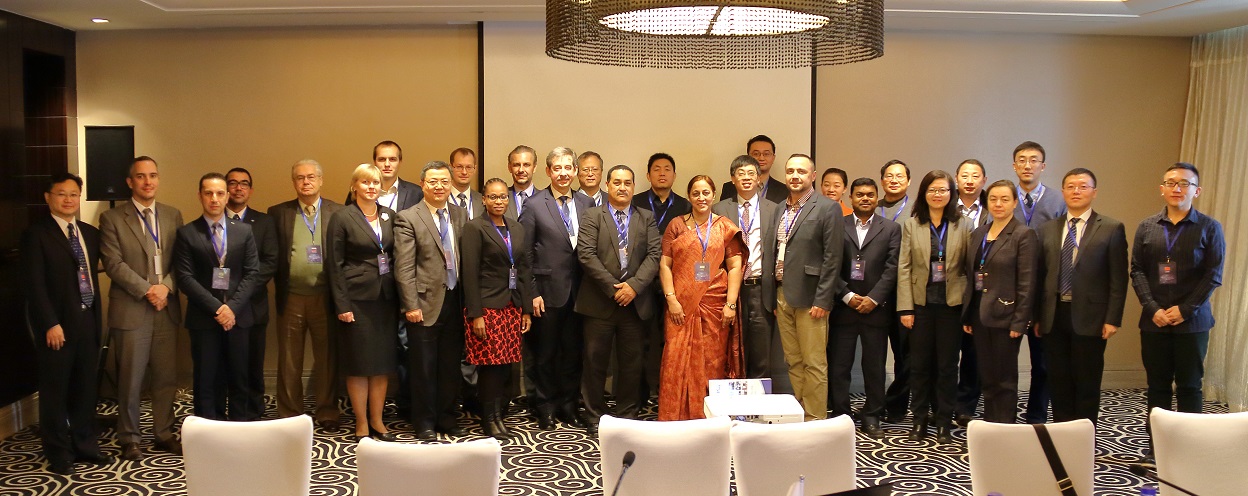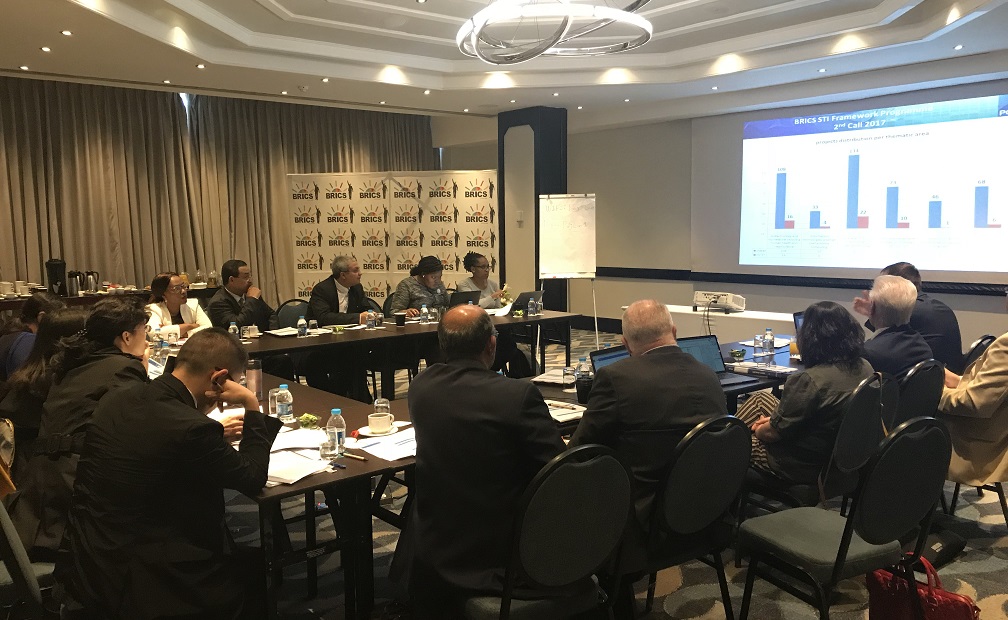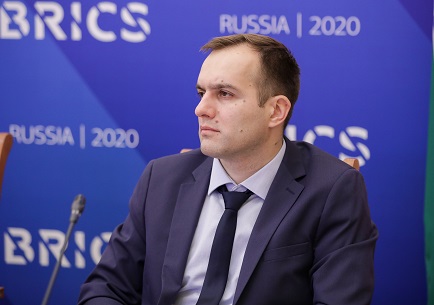
|
|
BRICS STI FP – 5 years!
A note from Head of BRICS STI FP Secretariat Yaroslav Sorokotyaga |
In July 2015 representatives of the BRICS funding agencies for the first time jointly sat together in Moscow and discussed an idea to launch a multilateral programme that should focus on support of joint research projects within BRICS. Activities on drafting of the architecture for the future cooperation programme and elaboration of statutory documents began as a follow up of the meeting. As a result of the work done, creation of the BRICS STI Framework Programme was endorsed in October 2015 at the meeting of the BRICS Ministers for Science and Technology. The BRICS STI Funding Working Group was also created in order to formalize meetings of the BRICS research funding agencies that would establish and govern BRICS STI FP.
On 18-19 January 2016 an inception meeting of the BRICS STI Funding WG took place in Beijing. The participants of the meeting agreed on the basic principles for organization and operation of the future mechanism for supporting joint research. Despite the difference in research funding mechanisms, national policies and legal framework, the funding agencies could find a common ground and reach an agreement on all modalities for launching the initiative on joint research funding. One of the features of the BRICS STI Framework Program was a multilateral approach: research involving representatives of at least three BRICS countries was a subject of support.

First meeting of BRICS STI Funding WG. Beijing, 18-19 January 2016
Within the next few months after the BRICS STI Funding WG met for the first time, 8 funding agencies from 5 BRICS states have signed the Arrangements for the BRICS STI Framework Programme, signifying the launch of the initiative. The 5-year pilot phase with start in 2016 was planned for the BRICS STI FP with annual calls for competitive grants to be launched on case-by-case basis.
The pilot coordinated call for BRICS multilateral research projects was successfully announced on the 18th of May 2016 bringing together 8 funding organizations for the joint support of research projects in 10 priority thematic areas. Reaching this milestone was not an easy task, but it was achieved in quite a short time comparing to other international multilateral programmes of similar nature.
The BRICS STI FP Pilot Call gained very high interest within scientific community of the BRICS countries, overcoming any expectations of BRICS STI Funding WG members. With the deadline for proposal submission set on 25th of August 2016, a total number of 320 projects with at least three partners from BRICS countries have been submitted in response to the call. 22 projects were prepared by project consortia representing all 5 BRICS countries.
The interest in the BRICS STI Framework Program has been rapidly increasing among the BRICS scientific community since its formation. So the preparation of the second BRICS STI FP call has began already during implementation of the pilot one. Within one month after selected 26 BRICS research projects were announced for funding as an outcome of the 1st call, announcement of the second BRICS STI FP call was published.
Despite decreased number of call thematic areas (6 areas in the second call compared to 10 areas in the first call) the number of submitted project applications rose on ~45% resulting in more than 460 applications received in response to the second call. Despite the number of projects supported as an outcome of the second call rose to 33, the overall approval rate dropped down to critical 7%.

4th meeting of BRICS STI Funding WG. Durban, 30 June 2018
The first phase of BRICS STI FP implementation foresee conduction of three joint calls and during the fourth meeting of the BRICS STI Funding WG (Pretoria, June 2018) the parties decided that the third call should provide the widest thematic coverage in order to review relations between the BRICS scientific community and the existing community interest for the priority topics. The implementation of the third BRICS STI FP call faced certain difficulties caused by the reorganization within some of the BRICS STI FP member-organizations as well as strengthening of bureaucratic restrictions. That combined did not allow to smoothly coordinate simultaneous launch of national call procedures. This state of affairs was the main reason for the decrease in the number of projects submitted in response to the call. However, the number of call organizers was enlarged to 9 research funding organizations. Nevertheless, according to the results of the third call, a record number of projects was supported - 35. In total, as an outcome of three BRICS STI FP calls, 93 projects in 11 scientific areas were supported.

Despite the relatively short period of BRICS STI FP existence, it has become a noticeable phenomenon in the scientific life of BRICS: several thousand scientists took part in its activities preparing over 1,100 projects. Of course as a young mechanism acting across states and actors with different management models, a number of challenges were encountered in the 1st phase of BRICS STI FP implementation, such as lack of coordination between national calls; different requirements/criteria and efforts needed for domestic proposal preparation etc.
In order to address the faced challenges and improve the procedures for the next 5-year implementation cycle of BRICS STI FP, aiming at further strengthening BRICS research cooperation and raising the efficiency of operational activities, on the 5th meeting in Campinas (September 2019) the BRICS STI Funding Working Group initiated the process of improvements to the call implementation mechanism. In this regard, it was decided to develop pathways for improving the architecture of call activities during the implementation of the second stage of the BRICS STI FP for the period of 2020-2024. The approval of the implementation plan for the second phase of the BRICS STI FP was scheduled for the second quarter of 2020. However, the global pandemic of the new coronavirus infection has adjusted plans and activities of the BRICS STI FP.
The agenda was shifted from discussion on the mechanisms for implementation of the second stage of the BRICS STI FP to overcoming the consequences of the global COVID-19 pandemic. In this regard members of the BRICS STI FP have approved a launch of an extraordinary call for interdisciplinary projects to tackle COVID-19. Thus, second quarter of 2020 was a busy time for rapid call preparations. On July 1, 2020, a BRICS STI FP call was announced in five topics related to the novel coronavirus infection. 111 multilateral projects were submitted in response to the call.
The global pandemic and the conduction of an extraordinary call although slowed down activities foreseen by the work plan of the BRICS STI FP, but did not shut them down. As soon as the projects submitted to the 2020 call were sent for evaluation, work on elaboration of the improvements for the second phase mechanism of the BRICS STI FP resumed.
The 2020 world crisis not only did not slow down the pace of work within BRICS STI FP track, but, perhaps, even gave it an additional impetus. Instead of one traditional annual meeting of the BRICS STI Funding WG, its participants held several videoconferences during the year, which facilitated and accelerated the preparation of solutions and their implementation. So, by the end of 2020, the results of the extraordinary call of the BRICS STI FP on COVID-19 were delivered. 12 projects received support as a result of the call, one of them being carried out by researchers from all five BRICS countries. During 2020, participants of the BRICS projects made presentations at several special events held during thematic WG meetings within BRICS cooperation tracks on STI and Energy. By the end of the 2020, the architecture for the implementation of the second stage of the BRICS Framework Program was approved by BRICS STI Funding WG: it was proposed to hold competitions for multilateral projects using a two-stage project submission procedure – pre-proposals and full proposals (we believe that this approach will minimize the efforts collectively spent by all participants for preparing projects for the calls, and benefit synchronization of national call procedures). During the second stage of the BRICS STI FP implementation, it is planned to present a new format of support - BRICS Flagship Projects, it is assumed that such projects will be carried out by researchers from all five BRICS countries and have increased funding.

Project presentations in 2020: RICS-MH (left) and HMAero (right)
Thus, having passed the five-year milestone of its existence, the BRICS STI FP has not only proved its relevance, but also its effectiveness. According to the survey conducted in the 1st quarter of 2020 by BRICS STI FP Secretariat among coordinators of selected projects, without the BRICS STI FP funding mechanism cooperation within more than 1/3 of the selected projects would have even never have happened without support; without BRICS STI FP support cooperation, 40% of selected projects could happen but at lower pace or with less ambitious goals. More than half of the respondents stated that BRICS STI FP selected projects already lead not only to the establishment of collaboration between research groups but also to the establishment of cooperation on a higher level, e.g. between research organizations, universities etc. There are cases when even the preparation of an application for a BRICS STI FP call led to increased cooperation among researchers or cases when after the first unsuccessful attempt, projects were not put aside, but finalized and supported as an outcome of the following call. Evidence of the success of the work that has already been completed by BRCIS projects can be found in articles published in leading scientific journals, obtained patents for inventions and implemented project results. A global multilateral approach in priority scientific areas of cooperation and a high-quality selection of projects (unfortunately for the participants, with ultra-high competition) made it possible to achieve high efficiency of the programme. Of course, the BRICS STI Framework Programme will continue to develop, offering new opportunities for joint scientific and technological cooperation within the framework of cooperation between 5 countries.












